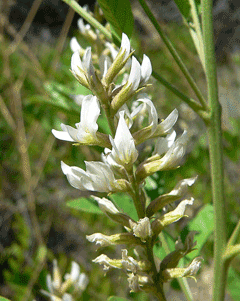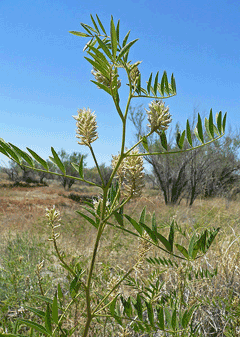 |
|
http://commons.wikimedia.org/wiki/User:Stan_Shebs |
 |
| http://commons.wikimedia.org/wiki/User:Stan_Shebs |
Translate this page:
Summary
Physical Characteristics

 Glycyrrhiza lepidota is a PERENNIAL growing to 1 m (3ft 3in).
Glycyrrhiza lepidota is a PERENNIAL growing to 1 m (3ft 3in).
See above for USDA hardiness. It is hardy to UK zone 4. It is in flower from July to August, and the seeds ripen from August to September. The species is hermaphrodite (has both male and female organs) and is pollinated by Insects.
It can fix Nitrogen.
Suitable for: light (sandy) and medium (loamy) soils. Suitable pH: mildly acid, neutral and basic (mildly alkaline) soils. It can grow in semi-shade (light woodland) or no shade. It prefers moist soil.
UK Hardiness Map
US Hardiness Map
Synonyms
Plant Habitats
Cultivated Beds;
Edible Uses
Edible Parts: Leaves Root Shoots
Edible Uses:
Root - raw or cooked[2, 46, 61, 203]. Long, sweet and fleshy[105], when slow roasted they are said to taste like sweet potatoes[183, 207]. They can be used as a flavouring in other foods and can also be chewed raw as a masticatory[177, 183, 212], making an excellent tooth cleaner and also very good for teething children. The root contains 6% glycyrrhizin, a substance that is 50 times sweeter than sugar[183]. The tender young shoots can be eaten raw in the spring[183, 257].
References More on Edible Uses
Medicinal Uses
Plants For A Future can not take any responsibility for any adverse effects from the use of plants. Always seek advice from a professional before using a plant medicinally.
Birthing aid Foot care Odontalgic Poultice Tonic
American liquorice was widely employed medicinally by a number of native North American Indian tribes who used it in the treatment of a range of diseases[257]. All parts of the body are medicinal, but the roots are the most active part. This species has properties similar to other liquorices which are widely used medicinally, though this species is rather neglected in modern literature. An infusion of the root is used to speed the delivery of the placenta after childbirth, it is also used to treat coughs, diarrhoea, chest pains, fevers in children, stomach aches etc[207, 257]. It is also used as a wash or poultice on swellings[257]. The chewed root is retained in the mouth as a treatment for toothache and sore throats[207, 257]. The mashed leaves are used as a poultice on sores[207, 257]. The leaves have been placed in the shoes to absorb moisture[257].
References More on Medicinal Uses
The Bookshop: Edible Plant Books
Our Latest books on Perennial Plants For Food Forests and Permaculture Gardens in paperback or digital formats.

Edible Tropical Plants
Food Forest Plants for Hotter Conditions: 250+ Plants For Tropical Food Forests & Permaculture Gardens.
More

Edible Temperate Plants
Plants for Your Food Forest: 500 Plants for Temperate Food Forests & Permaculture Gardens.
More

More Books
PFAF have eight books available in paperback and digital formats. Browse the shop for more information.
Shop Now
Other Uses
Nitrogen fixer. A dynamic accumulator gathering minerals or nutrients from the soil and storing them in a more bioavailable form - used as fertilizer or to improve mulch.
Special Uses
Dynamic accumulator Food Forest Nitrogen Fixer
References More on Other Uses
Cultivation details
Requires a deep well cultivated fertile moisture-retentive soil for good root production[200]. Prefers a sandy soil with abundant moisture[238]. Slightly alkaline conditions produce the best plants[238]. A very deep-rooted plant, it can be difficult to eradicate once it is established[238]. Unless seed is required, the plant is usually prevented from flowering so that it puts more energy into producing good quality roots[238]. Plants are growing very well at Kew[K]. This species has a symbiotic relationship with certain soil bacteria, these bacteria form nodules on the roots and fix atmospheric nitrogen. Some of this nitrogen is utilized by the growing plant but some can also be used by other plants growing nearby[200]. For polyculture design as well as the above-ground architecture (form - tree, shrub etc. and size shown above) information on the habit and root pattern is also useful and given here if available. The plant growth habit is a runner spreading indefinitely by rhizomes or stolons [1-2]. The root pattern is rhizomatous with underground stems sending roots and shoots along their length [1-2].
References Carbon Farming Information and Carbon Sequestration Information
Temperature Converter
Type a value in the Celsius field to convert the value to Fahrenheit:
Fahrenheit:
The PFAF Bookshop
Plants For A Future have a number of books available in paperback and digital form. Book titles include Edible Plants, Edible Perennials, Edible Trees,Edible Shrubs, Woodland Gardening, and Temperate Food Forest Plants. Our new book is Food Forest Plants For Hotter Conditions (Tropical and Sub-Tropical).
Shop Now
Plant Propagation
Pre-soak the seed for 24 hours in warm water and then sow spring or autumn in a greenhouse[200]. Prick out the seedlings into individual pots when they are large enough to handle, and grow them on for their first winter in a greenhouse. Plant out in late spring or early summer when in active growth. Plants are rather slow to grow from seed[238]. Division of the root in spring or autumn. Each division must have at least one growth bud. Autumn divisions can either be replanted immediately or stored in clamps until the spring and then be planted out[200]. It is best to pt up the smaller divisions and grow them on in a cold frame until they are established before planting them out in the spring or summer.
Other Names
If available other names are mentioned here
Native Range
NORTHERN AMERICA: Canada, Ontario, Alberta, United States, Illinois, Minnesota, Missouri, Wisconsin, Washington, Texas, California,
Weed Potential
Right plant wrong place. We are currently updating this section.
Please note that a plant may be invasive in one area but may not in your area so it's worth checking.
Conservation Status
IUCN Red List of Threatened Plants Status :

Growth: S = slow M = medium F = fast. Soil: L = light (sandy) M = medium H = heavy (clay). pH: A = acid N = neutral B = basic (alkaline). Shade: F = full shade S = semi-shade N = no shade. Moisture: D = dry M = Moist We = wet Wa = water.
Now available:
Food Forest Plants for Mediterranean Conditions
350+ Perennial Plants For Mediterranean and Drier Food Forests and Permaculture Gardens.
[Paperback and eBook]
This is the third in Plants For A Future's series of plant guides for food forests tailored to
specific climate zones. Following volumes on temperate and tropical ecosystems, this book focuses
on species suited to Mediterranean conditions—regions with hot, dry summers and cool, wet winters,
often facing the added challenge of climate change.
Read More
Expert comment
Author
(Nutt.)Pursh.
Botanical References
43
Links / References
For a list of references used on this page please go here
Readers comment